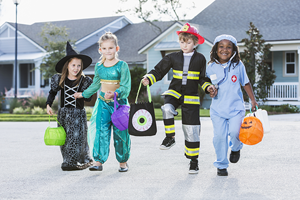Blog Categories
Search Blog
Blog Categories
Trick or Treat? 5 Ways to Make Halloween a Language-Learning Opportunity
Halloween and other festive holidays are a great way to teach new vocabulary and to help build your child’s language skills in a fun and engaging way. From acquiring a costume to carving a pumpkin, Halloween can be made into a language-rich opportunity for you and your family.
- Describing Halloween Costumes: Whether you’re planning to purchase your child’s Halloween costume or create it yourself, there are several opportunities to use adjectives, or describing words, when discussing costumes. These words can be used to describe the appearance of the costume (e.g., “sparkly”, “bright”), the material of the costume (e.g., “stretchy”, “soft”), and the emotions associated with the costume (e.g., “scary”, “funny”). You can help your child to explain their own costume and also to describe other children’s costumes on the night of Halloween. Turning this into a game can also make the experience more fun (e.g., “Who can find a costume that is sparkly?”; “Point to a costume that is scary”, etc.).
- Carving the Pumpkin: Pumpkin carving is a great way to encourage the use of verbs, or action words. Before carving, some families like to “draw” their desired pumpkin face. While cutting the pumpkin, verbs such as “cut”, “carve”, and “shave” can be used. While removing the pumpkin seeds, verbs such as “pull”, “grab”, and “remove” can be modeled. Once removed, you might “bake” and “eat” the seeds.
- Dressing for Halloween: While helping your child put on their Halloween costumes, several prepositions, or location words, can be reinforced. Differentiating words such as “in” and “on” by emphasizing that your child is to put their arms and legs “in” their costume and their mask “on” their face can be helpful. Other location words such as “below”, “beside”, “under”, “top” can be used while helping your child get dressed for Halloween.
- Anticipating the Experience: Before setting out for the evening, you can help your children to use sequencing vocabulary to understand the events of the night. Words such as “first”, “next” and “last” can be used to promote understanding of what they can expect. For example, you can explain, “first we will put on our costume, next we will collect candy, and last we will come home and try a piece of candy”.
- Describing the Event: When you’ve returned from the evening, you can help your child to describe the event by modeling use of past-tense vocabulary. You can model your favourite parts of the evening and highlight some of the special moments (e.g., “My favourite part was when I picked the blue candy”, “I liked when the skeleton danced”, etc.) Taking pictures during the evening to have a basis for your discussion can also help your child to remember and talk about the details.
With these tips in mind, you can teach your child new vocabulary such that they will be able to discuss their evening using more descriptive language. Keeping the evening interactive is always the best approach! Happy Halloween!!
TOP






